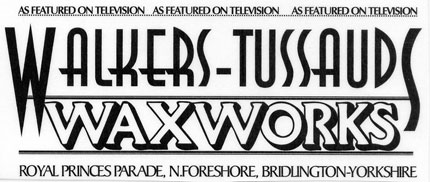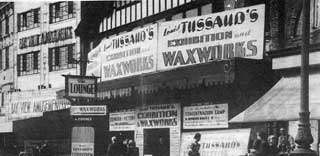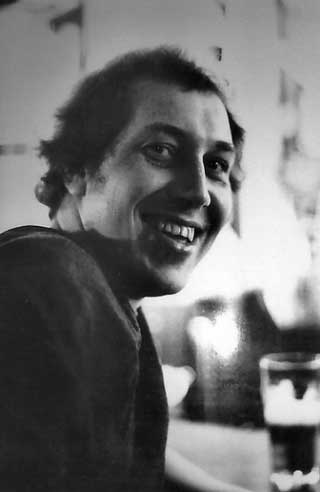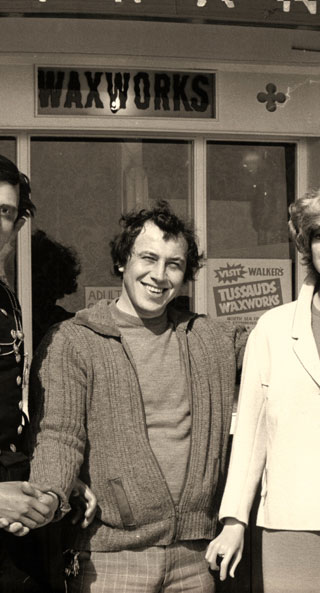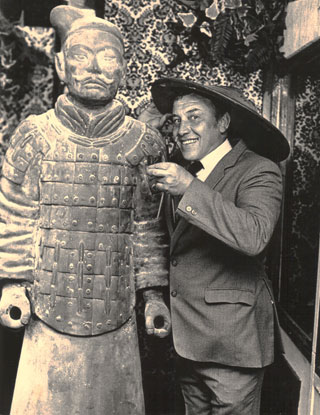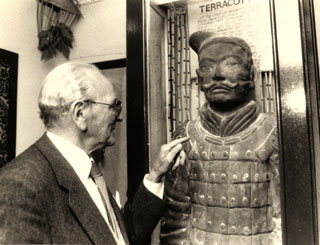|
|
||
|
Waxworks Brian Walker (1951-2001) was the man behind Bridlington's Walkers Tussauds Waxworks attraction, which operated from 1975 to 1993 on Bridlington's Royal Princes Parade. Brian ran the Harbour Top Amusements as well as maintaining the machines at his father's Casino Royale arcade. Brian's son, Wes, remembers that Brian had once left Bridlington for other business ventures: "He had initially gone independent in London in 1967 - where he managed to sell his one business twice! - before managing amusements in a triangle which embraced North Wales, Norfolk and Ayr (Scotland) and others." Returning to Bridlington and the day-to-day of the two amusement arcades, he concurrently traded as a distributor of pool tables and machines prior to the setting up of Walkers Tussauds Waxworks circa 1975. The first Walkers Tussauds Waxworks was on Bridlington seafront, within the colonnades of Royal Princes Parade. The initial base of Walkers Tussauds Ltd and Incorporated Exhibitions was a disused office above Casino Royale Amusements. The Walkers Tussauds workshops were located in some old stables to the rear of an adjoining property, which was also owned by the Walker family. The workshops were busy, with Tussauds exporting exhibitions to countries all over the world. As Wes explains, Walkers was not the first waxworks to be located in Bridlington: "One pleasant shock of surprise which hit us a few years back came about when a lady emerged with a still (alas, only laser copied), proving that despite the most innovative of intentions, there is nothing new under the sun. The 1946 picture showed the first summer season after Victory Over Europe, and with its splendid Swiss Cottage pinnacle, the Lounge's frontage onto the Esplanade. The unlikely denizen was its residing show - Louis Tussauds Waxworks! According to the lady it endured perhaps for two seasons, no more, but was for a time as grand as anything to be found offering in London's Piccadilly West End, Paris's Latin Quarter or Blackpool's Golden Mile. We were convinced that ours in 1977 was the first waxworks in the regional vicinity, yet the array of attractions for '46 which the Lounge presented we happened to cover 30 years later by pure happenstance, including a replica of Sir Winston - the very most difficult likeness of all to achieve of any subject you can name. For it also to be in our old property was the icing."
Brian Walkers father-in-law, Robert A Lenthall, played a key role in the waxworks business, remembers Wes Walker: "My maternal grandfather was a well-read ex-RAF chap who did valuable work for us in terms of cultural and historical research, not to mention his donating certain genuine articles that were stolen in a robbery-to-order and never recovered. the ineffectual pieces that were retrieved were kept holed up in dust-laden forensics and after two years apparently 'lost' in the security of our police force's inner sanctum." According to Wes Walker, his mother, Elizabeth Walker, also played an important role in the Waxworks: "Reticent where the showmanship element was concerned and completely unconcerned about gaining any recognition, the by-product from this is that she only really garnered credit in print/documentary as the costumier. She did in fact play an equal role in the daunting areas of set-building, prop-creating, sign-writing, publicity copyrighting, the personal operation and accounts, was responsible for the entire Egyptological foray, the arduous restoration (which ultimately wore her bones and joints out) and she did do a significant quantity of the hundreds of replica crania."
Wes Walker points out that the task of creating a model and its set was much more difficult for them than the waxworks creators of today: "One thing that is forgotten is that in those days, to seek inspiration from a frame of film, you couldn't readily rent a DVD. We were lucky to have the first video player in our resort (Charlie Walker put his order in for the second); otherwise one would have to deal at full rates with the London film distributors for 16mm copies to be played on cumbersome overheating projectors, relying upon one's persistence of vision for the eyes to return to the job in hand and to then sculpt the next stroke of a replica cranium. Also, there were less pictorial books around - those that were, were very expensive due to their amount of plates (no digital publishing)." Walkers Tussauds proved a resilient business in the face of competition from new attractions in the region. Wes explains that even the opening of Jorvik in York had little impact on the business, contrary to Robert Brown's views in Pennies by the Sea: "For the first three years of Jorvik's trading, our visitor figures for Walker Tussauds Waxworks Ltd on Royal Princes Parade beat theirs." But the business did noticeably decline as the 1980s turned into the 1990s: "By 1993 when the waxworks closed, it no longer did anything like the business we had been used to; we didn't make any overtures to people other than our intention to relocate overseas, which we did as Walkers Tussauds Sociedad Anonima." The Waxworks closed when the Council decided that the structure, within the sea wall of the lower foreshore, was structurally unsafe. The waxworks building was demolished when the sea wall was refurbished. Much of the remaining articles of the waxworks figures were sold beyond the Arctic Circle. It was in April 1994 that Walkers Tussauds Waxworks almost opened in Joyland. John and Jason Noble approached Brian Walker to bring existing elements of the waxworks into Joyland - during its major refurbishment - towards an entire new waxworks on the scale of Madame Tussauds in Amsterdam. Wes takes up the story: "It would have been towards the front of the Esplanade end and hypothetically was to have ventured upstairs prior to their plans for Utopia. In the event, it did not happen and the new interior was designed in a slightly different fashion." Another Walkers Tussauds venture involved Butlin's Filey, which closed down in 1983: "A demolition man named Trevor Guy Ltd was persuaded by the local authority to take it on from the Rank Organisation as a going concern. Walkers Tussauds boarded the project in the interest of keeping it open for the region, and created several attractions on-site namely The American Museum and Record Breaking Humans exhibitions, which were primarily waxwork-oriented." Sadly, Amtree Park (as Trevor Guy's new venture at the former Bultin's site was called) was to close only six weeks after opening and that particular Walkers Tussauds venture was no more. Click on the Walkers Tussauds sign below to go to a gallery of Walkers Tussauds-related photographs, all of which have never before been published. 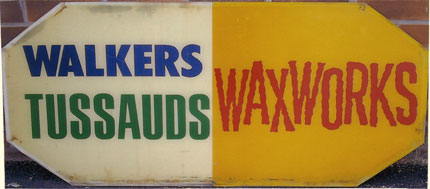 New Photograph: Original Walkers Tussauds 'plexi-sign', four of which were hoisted high up into the air on poles and was quite modern for the time (1975). Photograph: Wes Walker |
|
|
|
|
||
|
Published by: |
For further
information contact: |
|

